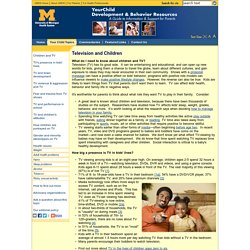

Responsive interactions key to toddlers' ability to learn language. Young children readily learn words from their parents, grandparents, and child care providers in live conversations, but learning from video has proven more difficult.

A new study questioned why and found that it's the responsiveness of the interactions that's key: When we respond to children in timely and meaningful ways, they learn -- even when that response comes from a screen. The study, by researchers at the University of Washington, Temple University, and the University of Delaware, appears in the journal Child Development. Three dozen 2-year-olds were randomly assigned to learn new verbs in one of three ways: training with a live person, training through video chat technology such as Skype that allows audio and video interaction via screen between users at different locations, and watching a prerecorded video of the same person instructing a different child who was off screen and thus out of synch with the child in the study.
Responsive interactions key to toddlers' ability to learn language. Responsive interactions help toddlers learn language. 9:29 a.m., Oct. 8, 2013--Young children readily learn words from their parents, grandparents and child care providers in live conversations, but learning from video has proven more difficult.

A new study questioned why and found that it’s the responsiveness of the interactions that’s key: When we respond to children in timely and meaningful ways, they learn—even when that response comes from a screen. The study, by researchers at the University of Washington, Temple University and the University of Delaware, appears in the journal Child Development. “This study suggests that children really need parents to respond to their little noises and vocalizations if they are to learn language. Being responsive to children even before they start talking is really important!” Said Roberta Golinkoff, who is a professor of linguistics, cognitive science and psychology, and the Unidel H. Article adapted with permission from the Society for Research in Child Development Inc. Apple iTunes App Store Metrics, Statistics and Numbers for iPhone Apps.
We originally created our metrics page in the fall of 2008 to celebrate the App Store reaching a milestone of what at the time seemed amazing, 10,000 apps.

There was a tremendous response to that page and to the App Store which is well north of half a million apps now. We’ve added a few more interesting stats and expanded the ones that were there onto this new page. Let us know what else you’d like to see on these page either in the comments below or send us feedback via email. We’ll do what we can to include them in the future. The source of the stats is the iTunes App Store itself. 9/2012: Metrics update. App Store Stats Summary Count of active applications in the App StoreDetails Total Active App (currently available for download): 3,047,937 Total Inactive Apps (no longer available for download): 214,478 Total Apps Seen in US App Store: 3,262,415 Number of Active Publishers in the US App Store: 655,557 Count of application submissionsDetails.
Images/NEWSLETTERS/reality tv and media literacy.pdf. Www.aacap.org/galleries/FactsForFamilies/54_children_and_watching_tv.pdf. Television (TV) and Children: Your Child: University of Michigan Health System. What do I need to know about children and TV?

Television (TV) has its good side. It can be entertaining and educational, and can open up new worlds for kids, giving them a chance to travel the globe, learn about different cultures, and gain exposure to ideas they may never encounter in their own community. Shows with a prosocial message can have a positive effect on kids' behavior; programs with positive role models can influence viewers to make positive lifestyle changes.
However, the reverse can also be true: Kids are likely to learn things from TV that parents don't want them to learn. TV can affect kids' health, behavior and family life in negative ways. It's worthwhile for parents to think about what role they want TV to play in their family. A great deal is known about children and television, because there have been thousands of studies on the subject. How big a presence is TV in kids' lives? TV viewing among kids is at an eight-year high. Common Sense Media. Parents See Media Violence and Access to Weapons as Obstacles For immediate release Thursday, January 10, 2013 Washington, DC and San Francisco, CA — A new nationwide survey of parents commissioned by Common Sense Media and the Center for American Progress and released today finds that 75 percent of parents say shielding children from violence is difficult.
